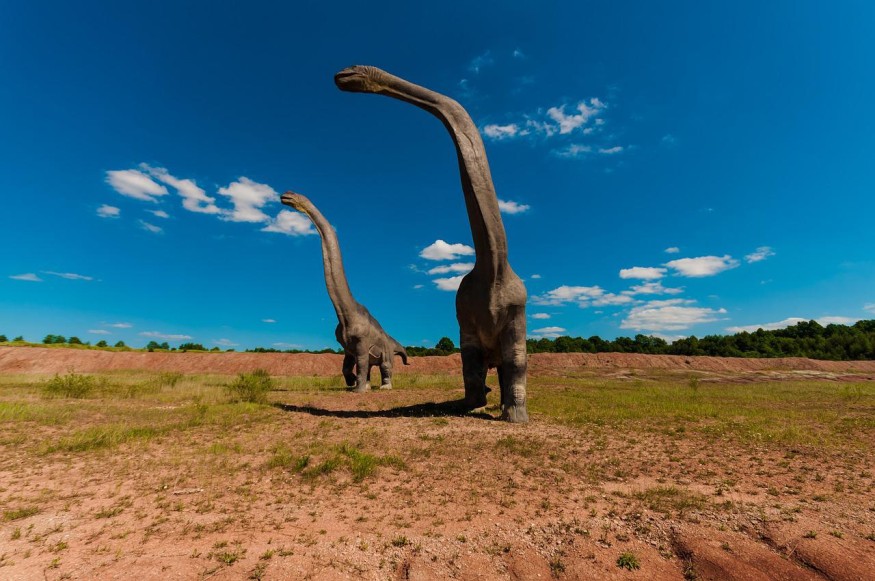A 7.5-mile-wide (12-kilometer) space rock smashed into Earth 66 million years ago, triggering a chain of events that brought the dinosaur era to an end. It was one of the most unlucky days for life on Earth from the dinosaurs' perspective, and a new TV series reconstructs what happened using newly uncovered evidence.
"Dinosaur Apocalypse," a segment of NOVA's science series, premieres on PBS on May 11 in two parts. Paleontologists will dig up fresh fossils in the documentary, which is narrated by Sir David Attenborough, and then see their discoveries come to life with dinosaurs portrayed using computer-generated images (CGI).

How Dinosaurs Died In The Eyes Of CGIs
The Thescelosaurus crept along the beach invisibly. The powerfully muscled dinosaur, which was around 12 feet long and weighed 500 pounds, was most likely seeking for food - or attempting to escape becoming a meal.
Thescelosaurus plodded about on two feet, the mass of its body leaning forward and a long tail stretching backward for support. It had prominent bony eyebrows and a sharp beak. As a series of unsettling natural forces disrupted the peace, the dinosaur raised its head and peered about, startled.
The ground began to shake violently, and water in the adjacent sea sloshed around in response. The sky was filled with blazing embers, which floated down and ignited the lush primeval forest.
Thescelosaurus became frantic and attempted to run, but it was too late. Everything instantly changed when a 30-foot-high surge of mud and debris swept up the seaway from the south, sweeping life and limb away. The dinosaur was trapped in the deadly flood, and the devastating surge cut its leg off at the hip.
That moment, 66 million years ago at the end of the Cretaceous period, when an Earth-shattering asteroid put an end to the dinosaurs' dominion, has been captured in time thanks to a spectacular fossil discovered last year at the Tanis excavation site in North Dakota. The skin, muscle, and bones of the three-toed Thescelosaurus are vividly visible in this wonderfully preserved limb.
Striking new fossils paint a picture of life right before the asteroid impact.
— NOVA | PBS (@novapbs) April 29, 2022
"Dinosaur Apocalypse: The New Evidence," hour one of a two-hour special, premieres on WED MAY 11 at 9/8c on @PBS: https://t.co/aOHtsyvgKj pic.twitter.com/CDZjxRFReX
ALSO READ : Are These Baby Dinosaurs? Viral Video Features What Appears to Be Little Sauropods Leaving Viewers Confused
Live Science said not all experts are persuaded that the Thescelosaurus died like this when the asteroid hit Earth. Some defer judgment until all of the data are published in peer-reviewed publications.
"We're never going to say with 100 percent certainty that this leg came from an animal that died on that day," Robert DePalma, a lead paleontologist at Tanis, told The Washington Post. "The thing we can do is determine the likelihood that it died the day the meteor struck. When we look at the preservation of the leg and the skin around the articulated bones, we're talking on the day of impact or right before. There was no advanced decay."
About Dinosaur Apocalypse
The whole episode revolves around Tanis's findings, a part of the Hell Creek Formation in North Dakota, where scientists believe they've discovered a huge cemetery of creatures that died shortly after the asteroid crashed.
"We're excited to bring viewers along on this journey as scientists excavate this extraordinary dig site," said NOVA Co-Executive Producer Julia Cort per WITF. "We're able to look over the shoulders of paleontologists uncovering some of the rarest fossils ever found in North America-perhaps in the world-that if confirmed, could help illuminate the most dramatic single day in the history of the planet."
In part two, "Dinosaur Apocalypse: The Last Day," the team discovers further evidence suggesting the Tanis fossils are victims of the extinction catastrophe that wiped out nearly 80% of Earth's animal species at the end of the Cretaceous era (about 145 million to 66 million years ago). A dinosaur leg that appears to have been ripped off a Thescelosaurus - a tiny bipedal dinosaur - in the aftermath of the asteroid impacting what is now Mexico's Yucatán Peninsula, where the impact created a deep scar known as the Chicxulub crater, is among the fossils.
PBS and BBC Studios Science Unit collaborated on the documentary. On April 15, 2022, a BBC One broadcast of "Dinosaurs: The Final Day with David Attenborough" aired in the United Kingdom. However, the new two-part NOVA special features additional experts commenting on the results were not featured in the UK edition.
PBS will broadcast "Dinosaur Apocalypse: The New Evidence" on May 11 at 9 p.m. ET, followed by "Dinosaur Apocalypse: The Last Day" at 10 p.m. ET. The episodes will also be available on the PBS video app and at pbs.org/nova.
RELATED ARTICLE : Here's Why South America Filled With Mammals From North America
Check out more news and information in Animals Science Times.











